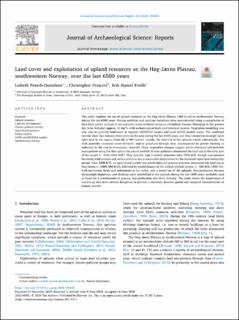| dc.contributor.author | Prøsch-Danielsen, Lisbeth | |
| dc.contributor.author | Prescott, Christopher | |
| dc.contributor.author | Fredh, Erik Daniel | |
| dc.date.accessioned | 2023-01-10T12:21:41Z | |
| dc.date.available | 2023-01-10T12:21:41Z | |
| dc.date.created | 2020-06-27T11:35:18Z | |
| dc.date.issued | 2020 | |
| dc.identifier.citation | Prøsch-Danielsen, L., Prescott, C., & Fredh, E. D. (2020). Land cover and exploitation of upland resources on the Høg-Jæren Plateau, southwestern Norway, over the last 6500 years. Journal of Archaeological Science: Reports, 32, 102443. | en_US |
| dc.identifier.issn | 2352-409X | |
| dc.identifier.uri | https://hdl.handle.net/11250/3042305 | |
| dc.description.abstract | This study explores the use of upland resources on the Høg-Jæren Plateau (360 m asl) in southwestern Norway during the last 6500 years. Human activities and land-use variations were reconstructed using a compilation of data from pollen analysis of six sediment cores retrieved along an altitudinal transect belonging to the present day farm Aniksdal (approx. 31 km2), with archaeological finds and historical records. Vegetation modelling was also used to quantify land-cover at regional (REVEALS model) and local (LOVE model) scales. The combined records show that humans were active in the area during the last 6500 years, and they created increasingly more open land in the region (from 60 to 90% cover). Locally, the land-use in the uplands varied substantially, but with generally increased cover of heath- and/or grassland through time, accompanied by greater burning as indicated by the rise in microscopic charcoal. These vegetation changes suggest active clearance and probable management using fire throughout the period studied. Hunter-gatherers dominated the land-use in the early part of the record (c. 4500–2400 BCE). They possibly kept livestock sometime after 3950 BCE, though management favouring wild animals and certain plants is also a reasonable explanation for the increased open land during this period. After 2400 BCE, an agricultural society was established and grazing activities dominated the land-use at Høg-Jæren (c. 2400–500 BCE), followed by establishment of the infield/outfield system (c. 500 BCE–1000 CE), with permanent fields and settlements in the valley, and a mixed use of the uplands. Hay-production became increasingly important, and shielings were established in the uplands during the last 1000 years, probably used as bases for a combination of grazing, hay-production and dairy farming. The study shows the importance of combining data from several disciplines to provide a relatively detailed spatial and temporal reconstruction of human activity. | en_US |
| dc.language.iso | eng | en_US |
| dc.publisher | Elsevier | en_US |
| dc.rights | Navngivelse 4.0 Internasjonal | * |
| dc.rights.uri | http://creativecommons.org/licenses/by/4.0/deed.no | * |
| dc.title | Land cover and exploitation of upland resources on the Høg-Jæren Plateau, southwestern Norway, over the last 6500 years | en_US |
| dc.type | Peer reviewed | en_US |
| dc.type | Journal article | en_US |
| dc.description.version | publishedVersion | en_US |
| dc.rights.holder | the authors | en_US |
| dc.subject.nsi | VDP::Humaniora: 000::Arkeologi: 090 | en_US |
| dc.source.volume | 32 | en_US |
| dc.source.journal | Journal of Archaeological Science: Reports | en_US |
| dc.identifier.doi | 10.1016/j.jasrep.2020.102443 | |
| dc.identifier.cristin | 1817384 | |
| dc.source.articlenumber | 102443 | en_US |
| cristin.ispublished | true | |
| cristin.fulltext | original | |
| cristin.qualitycode | 1 | |

